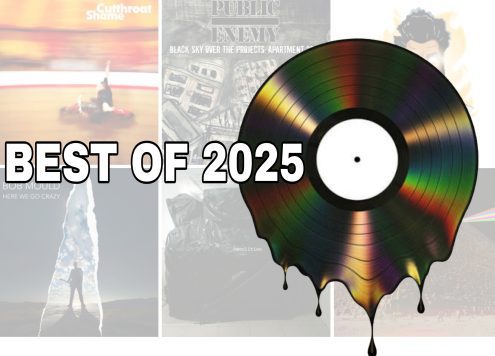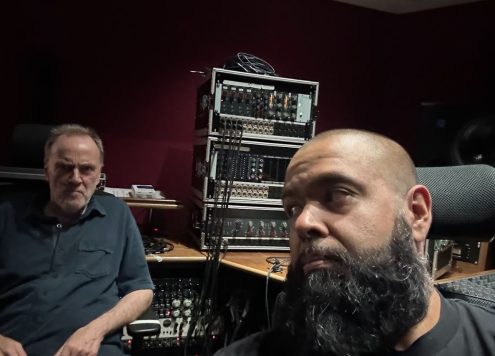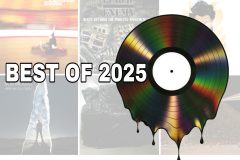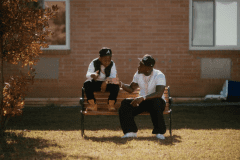Mouse on Mars, the long-running electronic music project of Berlin’s Jan St. Werner and Andi Toma, are about to release their 13th album, Dimensional People. The new album builds on the collaborative experiments of their 21st-anniversary album 21 Again, where they invited a host of artists from the all over the worlds of dance, electronic, indie rock and more to create a more than two dozen fascinating little worlds.
Like that album, Dimensional People sprang in part from a series of fortuitous collaborations with a huge host of musicians from around the world, including Justin Veron of Bon Iver, Bryce and Aaron Dessner from The National, Zach Condon of Beruit, Philly rapper Amanda Blank, Spank Rock and Ensemble Musikfabrik, a contemporary classical group based in Cologne, Germany, among many others. Check out the single “Foul Mouth,” which features rapping from Amanda Blank, music from Mouse on Mars and wordless but essential vocals from Zach Condon. It’s a fascinating, infectious blend of sounds (all at 145bmp as a node to Chicago footwork) that could only be Mouse on Mars.
The album you’ll hear represents only a possible interpretation of the experience: using an object-based mixing technology, Mouse on Mars have created an installation experience that allows listeners to experience the album as a physical space to move in.
Dimensional People is out Friday, April 13 on Thrill Jockey.
Ghettoblaster: Your new album takes a couple of different approaches: one that stems from your collaborative album 21 Again, where you worked with dozens of other artists, and the other was this more conceptual, spatial sound system. I was wondering if you could tell me about that.
Jan St. Werner: 21 Again was conceptually pretty straightforward, we wanted to invite people to an imaginary party and just like work on music with friends and collaborators and people we met over the last couple of years, and just make a record with them. So, actually kind of a present you make for yourself in a way. We had a couple loose threads we had experiments with the MIDI robots that our friends Moritz built, AKA Sonic Robots. We experimented with the robots, and we experimented with an ensemble from Cologne called Musikfabrik and tried to combine the robot percussion with these super-skilled new music musicians and write a piece for them.
At the same time, we developed a couple of mobile music applications like Elastic Drums and fluXpad, and we wanted to bring that into our production, so we had many loose threads. And then as well, basically along the lines of that we started becoming friendly with this group of musicians around a festival that happened in the Funkhaus productions complex in Berlin, which was former German Democratic Republic production center. We had our studio in the Funkhaus and at a certain point Hotel Michelberger, which is a Berlin artist’s hotel you could call it, like a new concept-type hotel run by a private organization so it’s not a chain, it’s a one-of-a-kind project. Those guys wanted to run this festival together Justin Vernon, the guys from the National, a few other people, Andre De Ridder the conductor, who we’ve worked with for various projects.
Actually, Andre brought Justin and Aaron and Bryce from the national into our studio to see if we wanted to participate in the festival that they had planned basically all around our studio, we had like a tiny … it’s a nice studio, but it’s just in this massively huge complex. So they just walked into our studio and said: “Look, we’ll just use the whole complex for the festival, do you guys want to be involved?” And we were actually a little irritated because we had just worked on a few ideas completely separate from the outside world. You don’t see many people in the corridors there, you’re actually on your own, then suddenly this whole entourage of musicians walks into the studio, and we didn’t really know them; personally, we had heard of them, but we were not very familiar with their music.
Anyway, out of this festival which we finally got involved with, quite intensely actually, we became friends with those guys and then met at various occasions and did various sessions and recordings together and eventually, we realized ‘okay, we also now have sessions we recorded with those guys.’ We already have sessions with an orchestra, robot drums, our own software, like some other weird musical sketches: totally disparate and heterogeneous sessions with those musicians, but why don’t we bring them all together and make it into one record? It sounds impossible and pretty insane, but this is what is always interesting to us, to try accepting these kinds of absurd or paradoxical experiments.
Along the lines came the possibility to check out d&b’s new spatial system, they call it Soundscape, it’s a new technology based on object-based mixing. It’s using a technique that’s existed for a couple of decades called wave field synthesis. This technique we were familiar with because there’s dedicated wave field synthesis based in Berlin at the technical university. We were very interested in this technique, so getting more familiar with d&b and becoming friendly with those guys, we realized to bring all these fused threads together we’ve got to find a way to step out of the routine of stereo mixing and getting crazy in the studio, trying to organize all the tracks so they would make up a perfect stereo mix.
Bring all this to the studios of d&b where we could sort out all the sounds and space, and let every sound have the maximum space to evolve and just let that sound be what it wanted to be. Accept the compromise that may be disparate and spread out and not directed, at least not directed in the sense of a spatial direction. So it’s all around you basically.
I think we were the first ones who really tried mixing a record in a special situation because d&b’s technology was basically intended to be used in venues. What they thought, this will be the future, live mixing and live application and concert halls, clubs, rock venues and just like dedicated listening spaces. They didn’t really think of this as a studio. We thought of it as an instrument, a recording studio. Which you could use like a spatial instrument, so this is what we were interested in.
GB: This spatial mix must have been complicated to do, and it is a pretty intensive experience to hear it—but it must also be intense as far as resources are concerned as far as putting together the system for allowing people to hear it, and very site specific. Do you have ambitions to display this mix of the album in other places or is it something that was just confined to that one space in Berlin?
JSW: If you hop on a train right now in New York you could actually experience it on Thursday and Friday [at the Dissolve Music @MIT Conference back in March]. D&b sets up their soundscape system at the conference that we’re organizing and beside all the talks and conference and the experimental music program we curated, we will also perform Dimensional People as a listening spatial installation. That’s your best bet for now [laughs].
But I’m sure were able to take it to other places too, it just really a pretty insane setup for a band like us. So we’re really dependent on d&b’s cooperation, and it just has to be the right spot and situation to set this whole thing up. It’s looking good so far; we have a few situations where we can present the spatial mix. We’re also working on events where we will play with musicians and actually combine them with the spatial work, so we’ll have both. Live musicians and the full-on sound skit spatial.
GB: Are you familiar with La Monte Young and Marian Zazeela’s Dream House in New York?
JSW: Yeah, very familiar, it’s a huge inspiration; it’s definitely a masterpiece of spatial understanding of sound, and not just the sound around you but also acoustic aspects of listening, definitely.

GB: When I heard the description, it’s the first thing that popped into my head, was experiencing that and it must be pretty intense to hear your music—which is so maximal in a lot of ways and has a lot of curly-cues and very intense details to it—to have that in such a large space, it would be a fascinating experience to walk through it.
JSW: Yeah, hugely. I think for us it was really a revelation, it felt like a coming out because for years you mix your music in stereo and you think that’s the only way because this is how people have to experience it. And even if you go and play it live, if you play through a PA system that transcribes everything into stereo so you have to have special projects, kind of like art-related ideas and actually the first steps we made into a spatial understanding how it really was with the Sonic Robots stations where we could place percussion instruments in space and have them play objects physically along with amplified electronic elements that we would play through a PA system.
So the step to work with a spatial sound system was actually the missing link it was like the last step. For others, it was like we could finally walk around in our compositions. This is how we actually hear the music in our heads, in our brains since the beginning, but it’s not how we had to transcribe it to the outside world. Really it’s not a defeat; it’s actually a celebration.
GB: It’s a really interesting experiment because it definitely brings the acoustic aspect of the electro-acoustic experiment: recording with acoustic and live instrumentation, but then also the making the acoustic space part of the performance as well is fascinating.
JSW: Absolutely, and what is also interesting to us, sounds have an organic quality to them because they keep changing, like each time you hear the same sound you keep kind of … the more you understand a sound, the more it keeps changing. It might be physically, the various instruments being played. But it changes in your perception, it changes in your consciousness, and you get to learn the sound pattern you associate with the sound. To have it as a spatial situation is to us a very organic idea for what a sound is. Us being a band that works mostly in the electronic field and uses a lot of synthesis and software and obviously electronic tools, working with musicians and we’ve always mixed acoustic instrumentation with the electronics, but this time we deliberately worked with musicians who had their own expression, idiosyncrasies, their own minds, their own glamour, their own history. We had to be careful with this context, with all those contexts.
Considering them being sounds, in this kind of spatial situation was the best way to deal with it because we could really also think of them as, “Okay we give the heading that much space at that moment in the composition, we let Justin come in from that door.” It’s like you’ve set up a play on a stage. You basically shoot a movie or something, it’s really a theatrical experience. So the whole record is also in a way, really like a novel in sound or a theatrical piece as well because it’s really a mise-en-scene, a stepping on stage in a way.
GB: Your new album’s also very vocal heavy, harkening back to albums like Idiology and some previous efforts you’ve had with vocal tracks. Did you guys have an influence on what the lyrics were? Or was that something the performers that you worked with brought to the stage?
JSW: It was all in the moment, specifically what happened in that very moment that channeled through the guests and back to us, and it was interesting, it was really a very organic process. None of the people, even if they were like prolific vocal performers, like front of stage people, none them had “this is my moment” kind of behavior. They were all like “Okay, what do you want with the music, how do you want us to integrate?” And we’re like, “just listen and feel what is missing or how you would comment on what you hear or how you would interpret what’s going on, or keep it running.” That’s all you are, you’re an element in a chain of reactions basically, and just keep the reaction running and be a domino and just kind of infinite domino chain.
And yeah, they were fine with it, and I guess if you get back to the lyrics, I guess there’s like the individual verses a larger picture of how the individual or the self-integrates within an organic kind of idea for society or group of people or an organism, it’s also like the projection of us towards the outside and the observation of the inside. But it’s also about liberation and also prejudices. Different genders and races and cultures and expectations still coming together. And I think this is the way the lyrics play as well, from Blank to kind of really hymnic moments like Spank Rock on “Aviation.” I mean that’s just an insane moment which was totally unexpected, I guess, each to everyone.
GB: On 21 Again, you worked with artists on individual songs, collaborated with them here and it seems like with this album you worked with people and recorded it, but did you know what bit was going into which song when you did it, or was it something you assembled when you had all the collaborations already recorded and viewed it more as a single album that you’d created out of a whole cloth?
JSW: We wanted to take the whole thing as one composition, this was our intention. We took care that each time we did a session with a musician and not knowing what we would do with this session, they would stay within a certain tempo and within a certain harmonic frame. So that was one side. One decision. Then we wanted to have one continuous narrative. We broke it up at the very end when we said … the narrative was strong enough. But from the very beginning, we wanted to create an album that was listened to as a whole one. Not a collection of songs, but one continuous state of mind, so to speak.
Sometimes with certain musicians who didn’t have that much time or we knew had a different approach in music, we gave them like a moment out of the album and said this is a moment you could come in and let it run as a loop or we expand the narrative or we said we could still define the narrative together off that very moment. Other musicians who had more time or we had all day to spend with just recorded actually endless sessions of certain wavelength patterns, certain harmonic patterns and then chopped it up.
With Justin, we had like a whole sequence of 25 minutes, and he went through the whole sequence and also laid out a narrative parallel to our narrative and then again, we decided, okay, your narrative makes you be a performer, at this moment and this moment. So, Justin was actually the main actor or the main voice in “Dimensional People Part III.” He pops up in “Dimensional People Part I and II,” more or less occasionally, more like an instrument. And then he has his peak in “Dimensional People Part III.” He did do sketches for the rest of the record, he did like a freestyle, associative kind of rap moment in “Foul Mouth,” and he came up with the term ‘Foul Mouth’, but we didn’t use it, Amanda Blank picked up on that one and that was the basis of or the initial spot for her lyrics, but we didn’t let Justin come back in.
So I hope that kind of gives you an idea of how we constructed it. It’s kind of like … we were kind of directors in a way.
GB: You’ve described this album at various points today as being a novel and as like a stage-play. And the last time I spoke with you was at the release of your Miscontinuum Album [Jan St. Werner’s solo album from 2015 – check out the interview in Ghettoblaster No. 40, true believers! – Ed.], which was also a stage production and you described it then as a kind of opera. This is obviously more of a pop-oriented album than that one, but did you use lessons learned when working on Miscontiuum Album when working on this album?
JSW: Yes, I feel like Miscontinuum to me was a huge learning curve because I really let myself approach voice in a much more deliberate way, and I hope I could bring the experience of that back into our work with Mouse on Mars. I was less hesitant and less shy about having real people being represented by their actual voices and not having to extract them that strongly. And also bringing in a narrative on various levels.
The thing with Mouse on Mars it that I feel one of our strongest connections and strongest tools is distraction, distraction as an actual tool. I think Miscontinuum had a very, very strong and consistent stream of thought. In a way it was a linear story, with all the glitches and micro distractions and associates there was a stream of thought, and that stream of thought was actually meant to be a loop. But Miscontinuum was really conceived as something that could run continuously as actually one narrative, you could enter at any point, as time that isn’t really a hierarchal structure, but really like a stream of energy you could constantly enter. So this was what this was about.
Dimensional People really is kind of a cubist style of arrangement. You change your point of view, and the whole image of what you see is shifting, and it’s shifting on the different personalities and characters of the people that are involved in the production, but also the people that actually evolve out of the production, that are kind of created through that narrative, like the new characters that are created, the new associations and hybrids and families that happen between these elements. I like to use that term, a shifting kaleidoscope, but I feel Dimensional People pretty much is that. But it is a kaleidoscope that really observes idiosyncrasies of human character. It still has this abstract sound quality; I think you can listen to it as an abstract sound record without even being too distracted by vocals and the voice elements.
But it also wanted to really be intimate with people, and intimate also with all their absurd and unsolved, inconsistent, incoherent ambitions and idiosyncrasies. So this is Dimensional People is, it’s really an ode to the human being as something that is imperfect, that is unguidable and also anarchic by nature, but makes sense in being together with others. Miscontinuum was a very single-minded observation. It was like a nearly monocular observation of certain states that someone would depict inside their consciousness.
GB: It seems like with the object-oriented mixing, you’ve created a situation where the stereo mix is just one possible variation on the album itself, it’s like there could have been dozens of different albums that you could have mixed down from this 3-dimensional creation that you’ve made. Was it difficult for you to settle on a final mix that you sent out into the world, or like a two-dimensional version?
JSW: Actually I will pass you on to Andi, but I had a really appealing thought that I wanted to share because it’s the heat of the moment. There’s like a technique that I use when I work with my students, and we also used it for the recording of the album, it’s multi-perspectivity in sound. It’s actually an idea of collective composing, so you use different microphones being operated by different people and you record a certain specific site or acoustic situation from different angles, while you move around. What I actually want to do, this Thursday or Friday when we have installation running here at MIT, I want to walk around with a handheld recording device and make a live mix album. Like just recording with a handheld zoom recorder.
So I would, you know you would approach a percussion robot, and then you would approach the sound that’s the brass section that’s coming from the left-right somewhere in the room, and so you really walk around according to how you hear the record. I think it would be great if actually, people would make bootlegs by walking around with handheld recorders and just, in a Grateful Dead way, make spatial recordings of the album. I think it would be pretty amazing. It’s just a thought I had, so I pass you off onto Andi.
Andi Toma: Because the digital audio engine which provides the sound to the speaker system, you have limited tracks available. The maximum was like 64 tracks which this machine can deliver. But our recording had many more tracks because there were a lot of stereo tracks. So the question was then, how to reduce the tracks to provide these to the 3D mix. This took awhile, but as we had experienced it already at the d&b 3D multichannel recording studio, I had an idea how to do it. Actually, today we will start to the mixing, and then I can actually tell more how it works in the end. It’s definitely a little bit more complicated than just having your stereo system and mixing into stereo, but the resolution of sound is so much higher with this system. We are really looking forward to working on this next phase. On Wednesday evening there’s going to be the first presentation, listening to the whole album. Now as everything is produced by the systems, maybe we can do it several times in certain locations.
GB: Do you think this process is something you would bring to your next album, or this is something you enjoyed doing, but now you’ve done it and let’s move on to something more traditional, or to a new experiment?
AT: I mean we have to be traditional because audio format is the stereo format, or at maximum Dolby surround format. It’s just something we do for ourselves. Because while we create music, we’re also listeners. It’s a process of creating and listening at the same time, and like mixing the album with the option to end up having 40 speakers with their special surround-delayed systems, it’s another process of listening to the stuff we’re recording. It’s very physical and very emotional. You hear many more details because they’re not kind of tucked into speakers and they have room in each, in their physical speakers. So, yeah, the process is quite an emotional experience.
GB: I bet. Do you find that you’re more attached to the 3D version of it than the stereo mix?
AT: Of course, of course, yeah. Because it’s kind of, you were involved in the recording so, listening back to these moments within the creation of this record, it’s amazing. It’s like … looking at the music with a microscope.
GB: Is it frustrating for you on a personal level to be able to create something and invest so much effort into and be pleased with the results, and then have only a handful of people be able to actually make use of it?
AT: Yeah, I mean, this is what happens, so that we have to accept. Of course, it would be great if this would be the standard. But, it won’t, it won’t be. So it’s more like an experiment and it’s not meant to be something too special. Because in the end, it’s the music, the character of the music counts. It works in stereo as it works in the 3D surround system. I mean, in the end, the quality of the music and what it tells, emotionally and musically, that always will be the most important thing. If the music has a heart, it sounds good on your iPhone … it transports its energy to just one speaker.
Website | Facebook | Twitter
Words by: Aaron van Dorn










Social Media